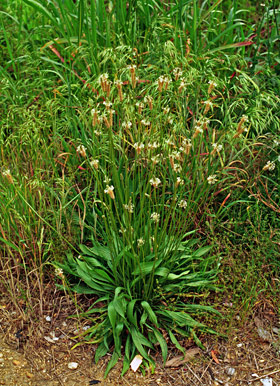Buckhorn Plantain (Narrowleaf Plantain, Ribwort Plantain), Plantago lanceolata

John D. Byrd, Mississippi State University, Bugwood.org.
IPM Steps to Reduce Buckhorn Plantain
1. Sample for Pest
Confirm the presence of buckhorn plantain before you treat.
Where to find it while inspecting: In lawns and any disturbed area such as roadsides, gardens and pastures.
2. Proper ID
Is it buckhorn plantain?
Size and Appearance: A clumping perennial in rosette shape. Long, narrow leaves (3–12") with noticeable parallel veins. Seed heads on tall, leafless stalks. Clumps of dense, white, tiny flowers at the tip.
3. Learn the Pest Biology
What is the life cycle of buckhorn plantain?
Life Cycle: Flowers from spring through autumn, dropped seeds germinate the following spring, at the top of the soil when soil temperature is right.
Preferred Habitat: Fairly weak roots except for the single taproot which can regenerate if the crown is cut off.
4. Determine Threshold
How much buckhorn plantain is too much?
Threshold: Plantain create unsafe footing on athletic fields and due to its continuous seed production, your threshold will be very low on sports fields.
5. Choose Tactics
Creating a healthy soil condition and understanding turfgrass’s needs is the first step in reducing turf pests. What can I do to treat, reduce, or prevent buckhorn plantains?
Best Management Practices: Diligent hand removal will work for some areas that do not have a well-established population. Mowing does little to reduce seed production, and this is a good example of when to wash down mowers between fields if you are traveling from a plantain-infested lawn to a high end field. Give your turfgrass optimal conditions to outcompete plantain: maintain proper soil pH: 6.0 to 6.8 (test every 3–5 years). Fertilize at the proper time for turfgrass root development, primarily fall (late spring at times when turf is weak and thin), irrigate if needed, mow at proper height (removing no more than 1/2 of the blade), amend poor soil, choose proper turfgrass seed for your conditions, buy quality seed, overseed thin spots in fall or early spring, remove thatch. Relieve compaction and overseed with desirable turfgrass species and cultivars on a regular basis.
Treatment Methods: Hand removal can work if done yearly and there are only a few plants. Herbicide treatments are available for established areas of turf—spot treatments are preferable. In landscape areas, mulching with fabric will reduce seedings.
6. Evaluate
Was the tactic successful? Record the date pests were first noted, and the tactic you used, and its success. Use one of our RECORD KEEPING tools.
For More Information:
North Carolina State University Turfgrass Center: Buckhorn Plantain
Remember:
When a pesticide application is necessary, all necessary and required precautions are taken to minimize risk to people and the environment and to minimize risk of pesticide resistance or pest resurgence. Pesticide use in your school may be prohibited or regulated by local policies or state and federal regulations. Risk reduction methods can include, but are not limited to, spot-treatment, the use of gel or paste bait formulations placed in inaccessible locations, injection into a crack or crevice, and other methods that reduce potential exposure.